Siena is another Tuscan power house of Renaissance art and architecture with its own key characters – perhaps the biggest names being Jacopo della Quercia and Beccifumo – as well as featuring some of our usual suspects from the Florentine scene, but with a very different feel to that city. It has its own history as a city state and was one of the major players of Europe back in the 1200s. It gained affluence from the wool and cloth industry and dominated the trade route between France and Rome, and was famous for its banks. It fell into decline after the Black Death hit in 1348, when it lost a third of its population and has, even now, a population well below that peak. The city is prosperous again now with its tourism, and also its bank, Monte dei Paschi, started in 1472 and once again at the forefront of the Italian financial world.
There is plenty to see here. Siena is distinctly drawn into 17 districts or ‘contrades’ – sort of clan areas started in the twelfth century from the different militia groups set up to protect the city. As you wander round you will see plaques on walls, flags or other signs of that area’s contrade, all named after animals or natural features such as porcupine, giraffe, goose, shell, caterpillar, forest etc. Every year the contrades field horses in the Palio, manic bareback horse races round the magnificent central piazza – the Campo – in July and August and Siena’s annual high point. We missed these of course, but the place was still bustling with tourists of every conceivable nationality.
As well as its contribution to world heritage Renaissance art and architecture, Siena has St Catherine. The pure serene-faced white and blue clad saint crops up frequently in artworks and souvenirs. We didn’t visit the house of her birth, but at the church of San Domenico you can see her head. This is guaranteed to be genuine and indeed does somehow look like the person in all the portraits. No peaceful burial then for so many of these saints – the fate of their earthly guise is to be chopped up and bits of them distributed hither and yon, displayed in ornate caskets.
On our first wander round, we were daunted by the sheer volume of sights to be seen, and decided it made sense to stay a little longer than we originally planned. This also meant that some mail we were urgently waiting for could be forwarded to us at the campsite (thanks again to Matt and Ryo for their help with this). We could also try and pace ourselves. Although we’re now into autumn and the mornings and evenings are noticeably cooling down, the middle of the days are still in the high 20s celsius. And this is a place with very steep ups and downs too.
We started by getting our bearings at the Campo. The sloping semi-circular piazza was originally a Roman amphitheatre and is dominated by the soaring tower of the Palazzo Pubblico.
Our first full day in town was a wander round and a chance to plan our stay in the city, and of course to have a late lunch at a reasonably priced and really cool restaurant, Boccon del Prete. Although there were other tourists here, it was above all a locals’ restaurant with a friendly hospital doctor at the next table who had to rush off when his on-call phone went, and a graduation lunch party in the cellar. The food and wine were delicious, the service ever so slightly chaotic.
Wednesday morning is market day and of course we had to pay a quick visit to the sprawling cheap clothes and hardware stalls. Our next call was to buy a joint ticket for entrance to the Duomo (or cathedral) as well as the Baptistry, Crypt, Duomo museum (Museo dell’Opera del Duomo), and San Bernardino Oratory (valid for two days). This made visits to all these a little more affordable.
Siena’s Duomo is perhaps the most incredible church of the trip so far – the interior is more interesting than the Duomo in Florence.
Its extravagant exterior filled with statuary by Giovanni Pisano and his workshop (the originals are now in the museum and replicas fill their places). The artistry and craftsmanship of its marble floor, or pavement, is stunning. Decoratively patterned with different colours of marble, it also features many beautiful images painted in marble by the foremost artists of the time, notably Beccafumi, whose images include dramatic use of lights and darks and drawing-like cross-hatching. It’s kept under wraps most of the year to protect it and only on view in all its glory for a couple of months. For once, our luck was in and we got to see it. It lived up to its reputation.
Nicolo Pisano’s pulpit and Donatello’s bronze of St John the Baptist are among many other treasures. Just off the central nave is the Libreria Piccolomini, commissioned by Francesco Piccolomini who was Pope Pius III but only for 10 days, to house his uncle, Pope Pius II’s books. The frescoes that fill the ceilings and walls in this space are Pinturicchio’s and tell the story of Pius II’s life. The multitude of detail and the vibrancy of the colours is so breathtaking I found it hard to leave. I also loved the illuminated manuscripts on display. For once, one could take photos.
As ever though, we narrowly avoided tour group rage, particularly when their guides are giving loud lectures totally ignoring the pleas for silenzio and no flash. The lack of consideration for other visitors and the seeming unawareness that these are sacred spaces continues to astound us.
We still can’t quite grasp why so many people insist on having their photos beside every sight, even places and things you wouldn’t call especially thrilling or appropriate. Half the time they don’t even smile for the camera. Is it that they need proof that they were at these places? In the Duomo in Siena a Japanese couple had their photo taken in the central nave holding up bunny ears behind each others’ heads and grinning broadly. I say no more!
The Baptistry, beneath the Duomo was stunning too, the font featuring bronze scenes by Donatello, Ghiberti and Jacopo della Quercia, and more frescoes mainly by Vecchietta. The Crypt was more interesting as a space, with only fragments of older frescoes.
Lunch was a luscious freshly-baked pizza eaten on the steps of the Baptistry, giving us the strength to embark on the Museo dell’Opera del Duomo. This houses the originals of the statuary from the Duomo’s exterior, and a Sienese master painting, Duccio’s Maestà, the Duomo’s altarpiece until 1505. The highlight of the museum though, was the chance to climb to the top of the only wall built as part of a vast abandoned project to build an additional nave for the Duomo back in the 14th century. This commanded views across Siena and was worth the wait as there is only room for a limited number up there.
What a lot in one day, and it wasn’t over yet. By now we felt in need of an early evening refreshment and Siena is not big on bars as such. We had read about the Enoteca Italiana though, a sort of state run wine bar and store situated in the fortress and decided to wander back over to this area, where the market had been, to explore. The Enoteca is a great place to try an array of Italian wines by the glass at a stylish wine bar right within the fortress walls with a terrace, there is also a restaurant. Or you can buy from the store. The magnificent display of 900 or so different bottles from all over the country is in the cellar below. We tried four different reds between us, with the Rosso de Montalcino our firm favourite. Feeling suitably enlivened, we headed up onto the walls outside to watch the huge red sun slowly dip below the horizon, dodging joggers running circuits around the perimeter. The sounds of jazz floating out from the practice rooms of the Jazz Association, also based here, added further to the ambiance.
We were tempted back to the city centre to Boccon del Prete again for dinner – a cheese platter of three ages of Pecorino and walnut bread with a fruit mustard, followed by tender rare steak slices over olive oil roasted potatoes, and we went for the same dessert we had at lunch yesterday – the pear sponge in vanilla and sweet wine sauce.
After such a full day, we decided to take it easier on the Thursday, starting off with the final visit of our first joint ticket – San Bernardino’s Oratory. Except that the doors were closed and it didn’t open until one. So we went to the Pinacoteca Nazionale – an art gallery with a fabulous collection of Pre Renaissance, Renaissance and some post Renaissance art. I had to leave my passport for the key to a locker to leave my bag in – I got ticked off in Italian for not knowing this, although the sign was nowhere near the ticket window! The museum is most famed for its fondi d’oro works. These are breathtakingly beautiful paintings on guilded backgrounds, mostly of madonna and child with saints gathered round and variations of this theme. After the umpteenth room of these we were starting to fade out in spite of their wondrousness, and there were two more floors to see. This was a museum too far for us after yesterday and we still had some major things to see in town.
A quick sandwich for lunch – we are learning to ensure we take proper breaks from sightseeing, so we don’t get too much culture overload, and spend head space away from too much visual stimulation. And of course a rest for our weary feet. Then it was back to San Bernardino. Thankfully, a beautiful but short visit. We headed back to the campsite by mid-afternoon for some, we feel, well earned recuperation!
Our final day in the city, and after the cultural overload of the last few days, it was with trepidation that we bought our last joint ticket for the Museo Civico and L’Ospedale di Santa Maria della Scala – two more ‘must see’ sights crammed with artworks. The buildings themselves are worth seeing in themselves, the Museo Civico is within the Palazzo Pubblico – the town hall. The historic ornate rooms are filled with frescoes, some of which feature rare for the time secular subjects, such as Ambrogio Lorenzetti’s Allegory of good and bad government. But where was the rest of it? We ran out of rooms to see far sooner than expected. What was open to the public was far less than, say the Palazzo Vecchio in Florence. It was a secret relief though – we could have a snack and rest and save ourselves for L’Ospedale di Santa Maria della Scala.
Once we found the entrance, being rather mislead by hordings for a forthcoming exhibition of rather soft pornographic illustrative modern art, we embarked on what turned out to be a unique and thrilling museum visit. Our aged Time Out Guide (Florence and Tuscany), describes this as a ‘museum in progress’, and it still is. As its name suggests, this was the city’s main hospital for 900 years up to as recently as the 1980s.
There was a press conference in full swing in one of the ground floor rooms, possibly to do with the new exhibition, but there were Beccafumi frescoes to be seen elsewhere and a sizeable chapel remodelled in the 15th century and recently restored. It also boasts more secular frescoes describing the original work of the hospital by Domenico di Bartolo (1400s), including the taking in and educating of abandoned babies. But after doing the ground floor, we wondered if that was it? If this was a must see why was no one else here? Then we were ushered downstairs to the first of two floors below street level.
Firstly we entered the dark eery chapels, the Oratorio di Santa Caterina della Notte, where followers of Catherine of Siena and other medieval confraternities worshipped. We could imagine someone stepping out from the shadows – a wonderful location for the telling of ghost stories. We entered the treasury area which seemed to be empty. We followed the lit ancient brick passages and suddenly came across golden objects displayed in cases seemingly suspended in mid air around different corners. What a wonderful way to build intrigue into a museum wander. One gold and glass reliquery held a nail from the crucifixion. As not a lot was made of this, can we assume that thoughts have been given up of it being genuine?
The intrigue wasn’t over yet. We descended an unlabelled flight of stairs to the level below (second level below ground) and found ourselves in an unfinished area of rooms and passages deep in these extensive brick and earth cellars. Empty display cases, incomplete info panels, dust sheets and tools spread around. There was no rope across and no staff or signage to indicate the right way to go, but it was all so beautifully lit and enticing and surely we would eventually find where we were supposed to be. Nothing stopped us so we kept exploring these wonderful tunnels and chambers reaching cavelike right into the earth itself, staircases cut short half way up walls, blind alleys and steps up and down. All the time with the exquisite emotion of doing something illicit. There was a frisson of fear that suddenly the lights would be switched off and we would be left in total darkness in this maze so deep underground. A chill shiver up ran up my spine when I realised that one earth wall contained layers of bones – the original charnel house of the old hospital. What had started out as a lack lustre visit to yet another museum had turned into a unique subterranean stroll of discovery.
After many twists and turns we did find the open part of the archaeological museum with its wonderfully displayed and lit ancient etruscan, hellenic and roman artifacts. We only saw one other visitor and one warden on this whole vast level. We saw that the warden had a bank of screens behind her desk… we had been on camera the whole time!
It was an unforgettable end to our sojourn in Siena, and in keeping with the rest of our stay, was followed up with a late lunch.


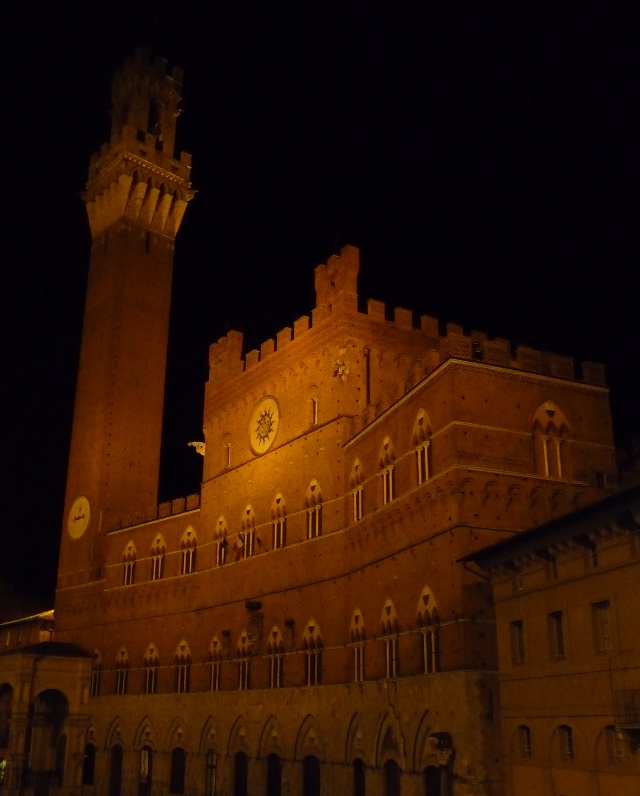
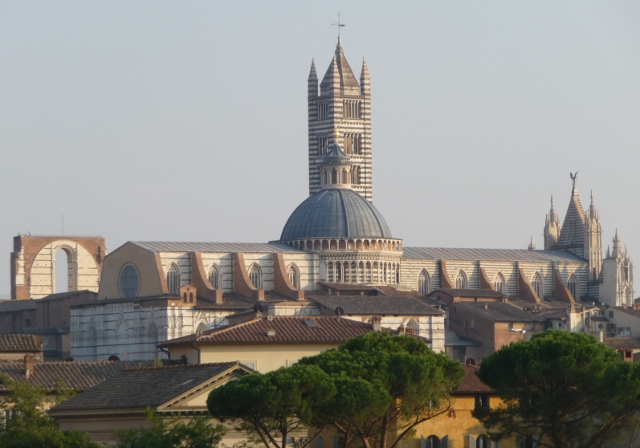
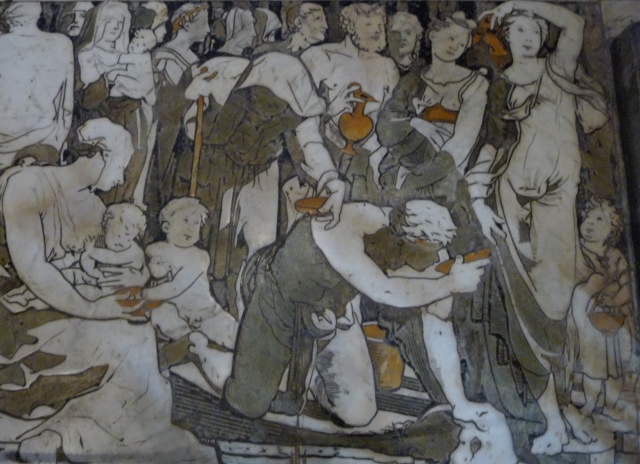
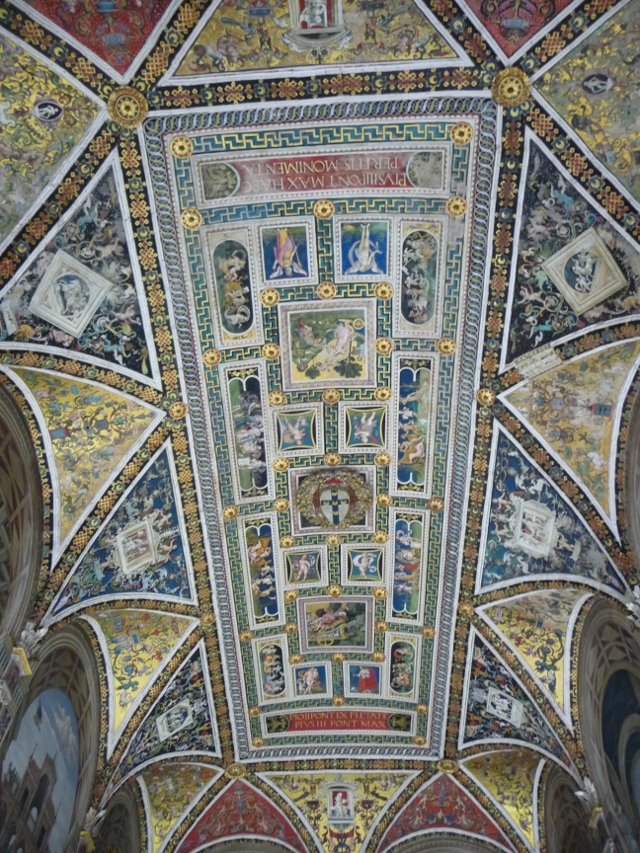
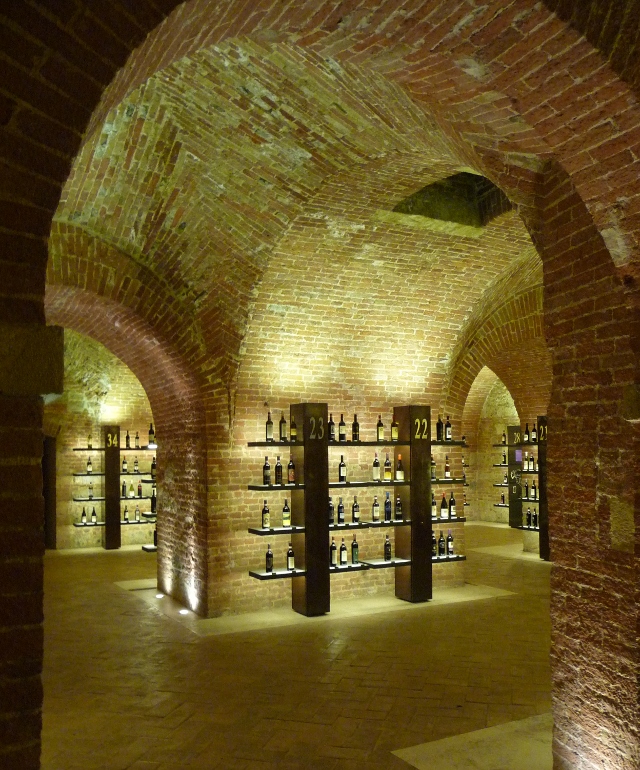
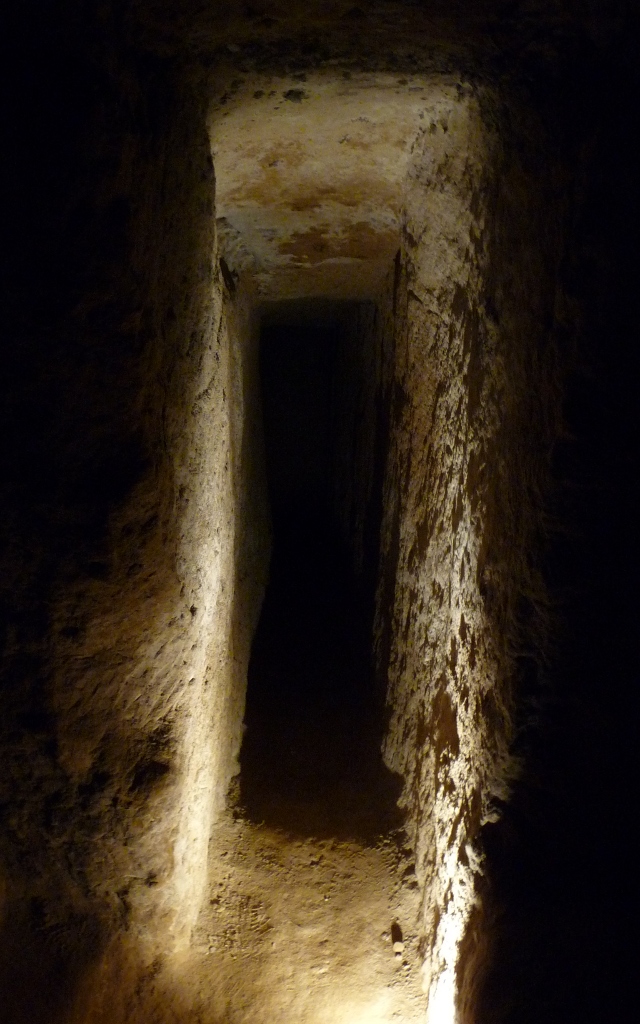


I love this blog and eagerly await the next instalment. It really makes me want to be there – which most people’s travel notes and holiday snaps don’t! It is also beautifully written – which gives an old pedant like me such pleasure. More, please….
David
Glad you’re enjoying it, David! We’re doing our best, but internet connections are a little flaky of late – with a side order of “too busy doing to write about”…
Pingback: Answers to some frequently asked questions | Wherever the road goes…